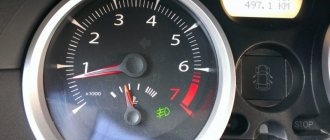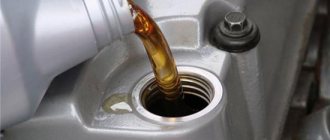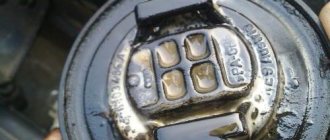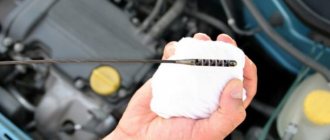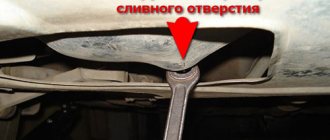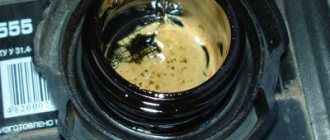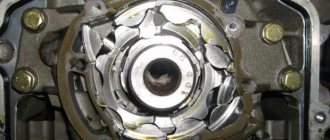While operating a vehicle, many motorists notice oil leaking from under the oil filter. This problem may be relevant both for owners of fairly old cars with high mileage, and for relatively new internal combustion engines.
In the first case, oil flows in the area of the oil filter due to the fact that the oil pump of the lubrication system may not have a pressure reducing valve that prevents excess pressure in the system. Most often, the problem appears after a cold start in winter, when the oil thickens in the crankcase of the power unit. The thick lubricant simply does not have time to pass through the filter, resulting in oil being squeezed out.
We also recommend reading the article about why oil is squeezed out through the breather. From this article you will learn about the causes and ways to eliminate such a breakdown.
As for modern engines, leaks for this reason are not normally allowed, since the presence of an excess pressure relief valve in the design of modern systems eliminates this possibility. For this reason, an oil leak from under the oil filter housing is a malfunction and becomes a reason for diagnosing the power unit.
In this article we will talk about the reasons why oil leaks from the oil filter, what to do if an oil leak is detected from under the oil filter cap or housing, and also how to fix it.
Causes
For what reasons can motor fluid leak from under the crankshaft oil seal (hereinafter referred to as SCV)? This question interested every car enthusiast who encountered this problem. Now we will try to give a detailed answer to this question. There may be several reasons, as you might understand.
Oil leak from under the front SCV
First, you must decide which oil seal is leaking. There can be two of them in a vehicle:
- Rear oil seal. As a rule, its service life is long and is often determined by the life of the vehicle. In terms of its dimensions, this element is large.
- Front oil seal. It is smaller in size, but it is also less durable, since in practice it fails much more often than the rear oil seal.
You must clearly know which oil seal is leaking. If an oil leak has been detected at the rear of the engine, then it is necessary to visually check the pan and gearbox unit. To understand what kind of oil is flowing, drop it on the surface of the water. If the transmission fluid immediately spreads across the water surface, the engine fluid will remain in a droplet.
Loading …
Now let's move directly to the reasons why the crankshaft oil seal may leak. As stated above, there may be several of them:
- One of them can usually leak when the total mileage of the vehicle exceeds 100 thousand kilometers. This is often caused by vibrations in the crankshaft, which wears out the inside of the oil seal, which should initially be a tight fit. However, as it breaks down and loses its shape over time, it cannot adhere tightly to the crankshaft surface.
- In addition, the problem may arise in another case. For example, if the vehicle has not been used for a long time or has been parked outside for a long time during winter cold, the oil seal may dry out or freeze and harden due to frost. In this case, it will also not be able to press tightly against the surface of the crankshaft.
- As for new elements, the oil seal may leak for other reasons. In particular, it may be the disgusting quality of the manufactured part itself. Please note that poor quality of the element will one way or another affect its performance, so do not install products from unverified manufacturers on your vehicles.
- Incorrect installation. It is also one of the reasons why oil leaks from under the oil seal. In particular, this is possible if the element is installed unevenly. As a rule, the oil seal is installed in the required position and, using a hammer, without applying any effort, the oil seal is hammered into its installation location. However, oil seal manufacturers recommend that their consumers use special equipment for this.
- Engine malfunction. Engine fluid leakage can also occur due to a malfunction of the internal combustion engine itself. If defects appear in the operation of the engine, for example, the pressure of crankcase gases in it has increased, then these same gases can simply squeeze out the oil seal. As a result, a gap may form at its point of contact with the crankshaft, through which lubricant will flow out.
- Oil filter leaking. Also a common problem. Sometimes motorists mistake this problem for a seal leak and change the seals, as a result of which the filter will still need to be replaced.
Car engine disassembled
Now let's clarify some details about the production of oil seals. You should not purchase parts from unverified sellers or manufacturers unknown to you. This way, you can not only buy a low-quality oil seal, the installation of which will backfire on you, but will also cause new problems. Well-known and trusted manufacturers of elements today are:
- Victor Reinz;
- Elring;
- Goetze.
It should be noted that the products of these companies end up not only in automobile stores, but also in the used parts market.
How to choose a quality filter
Very often, oil leakage can occur due to the use of a low-quality filter.
In order not to buy a low-quality counterfeit, you must remember the following:
- When purchasing an oil filter, you should pay attention to the condition of the packaging. If there are signs of deformation and there are large holes in the case, then this is a sure sign of counterfeit.
- It is necessary to study the technical condition of the polymer sealing ring and the filter membrane. The height of the sealing ring should not be more than 0.8 mm. above the surface of the lid. A high-quality membrane should be free of irregularities and of the same color.
- You need to buy a filter only in certified auto stores that have official registration and a long period of operation.
- You should not chase cheap filters, since very often low-quality material is used for their manufacture, and they have a limited service life. By applying the above recommendations in practice, you can minimize the likelihood of purchasing a filter with low technical characteristics.
Troubleshooting Methods
1.Elastic band deformation
Sometimes, when installing the oil filter rubber, he forgets to lubricate it separately, which is why it becomes deformed during installation, and, for example, it can become skewed. If this happens, you should remove the filter barrier and apply lubricants to the rubber band. After this you need to reinstall it in place. If the gasket deformation cannot be corrected, then it is better to replace it.
2.Unscrewed filter
During the next lubrication change, when installing the oil filter, it may not be tightened, which is also why oil sometimes leaks. To fix this and remove the leak, you need to use your hands, without using any other means, so as not to damage it, just screw the filter all the way.
3. The filter will be tightened
This problem occurs if, when changing the lubricant, the filter is once again tightened too much. In such cases, it is advised to remove the filter to assess the condition of the gasket - if the rubber is damaged, it must be replaced with another one. After this, the filter is installed in place, as in the previous case, without applying much effort - twist it by hand until it stops.
4. Damage to the barrier surface
Oil also drives under the filter rubber bands if the mating surface of the barrier itself on the motor has been damaged; the ebb that is directly adjacent to the rubber band must have a flat surface, otherwise it should be replaced.
5. Increased engine oil pressure
Oil pressure can be excessive for a variety of reasons. As a rule, then you have to replace the lubricant with a better one or look for another barrier. In the first case, this may be caused by poor-quality additives, which is why a large amount of gases from the burnout of the lubricating fluid accumulate in the system, and the ventilation does not have time to remove them. In this case, you first need to find the cause of the increase in pressure, and then begin repairs.
6. Cold engine
When oil leaks due to a cold engine, the problem is most likely in the internal structure of the car. This reason has already been discussed above. Since older cars most often do not have a valve to regulate the lubricant pressure, a change in pressure may result in an oil leak. In this case, most likely the car does not have an automatic valve installed on the outside, and if it does, it may be worth checking to see if it is working properly. In order to avoid further leaks, it is worth warming up the engine and inspecting the valves and oil filter.
7. Filter contamination
All you need to do in this case is simply replace the filter. It is also worth calculating the force so as not to lead to deformation of the rubber gasket - you should not use a wrench for this. It is enough to screw the filter tightly by hand.
8. Damage to the pressure reduction valve
Because of this, oil usually leaks when the lubricant and filter element are in satisfactory condition, but the leak continues. To eliminate a leak, first remove the valve without removing the pump, using a rag and keys. Remove the timing belt cover, unscrew the valve plug, removing the spring. The valve is removed and inspected for damage and scoring. Sometimes it is necessary to replace the spring if a bend is detected or the nominal height (44.72 mm) differs from the actual one.
The main reason why your oil has been squeezed out through the oil filter is mainly due to starting a cold engine. The oil is thick and does not have time to pass through the filter device. This mainly applies to older cars with oil pumps without a bypass valve. Naturally, this does not happen on new cars, well, only if it itself is poorly screwed on.
Once, after another seasonal oil change in the fall, naturally with the replacement of the oil filter, I started the car in the morning, everything seemed to be in order, but then I noticed that the oil pressure began to drop. I opened the hood and checked the level, there was no oil. I got out of the car and only then saw that all the oil was under the car. It turned out that it was squeezed out through the oil filter.
Somehow the oil filter gasket was squeezed out, and then the oil side itself was twisted. There was no frost, so there was no risk of the butter being too frozen. I still don’t understand the reason, I bought a new one and installed it. Imagine the surprise when a few days later he was squeezed out again.
I removed the filter again and placed it next to the old one and only then noticed the difference between them. The new one had only 4 oil inlets, while the old one had 8 (photo above).
Maybe there was also some difference in the design of these filters, I don’t know.
This time, when buying a new one, I paid attention to this and, even though the seller did not admonish me that there was no difference, I still chose the one I needed. I replaced the filter and this problem that squeezed oil through the oil filter was no longer there
Fixing the problem
The valve can be removed without removing the pump itself.
What will you need?
- a set of keys;
- rags.
Stages
- Remove the timing belt cover.
- Unscrew the auto valve plug.
- We remove the spring.
- We take out the valve and check it for scratches and mechanical damage.
- Check the condition of the spring itself. There should be no kinks on it, and the height should be 44.72 millimeters, otherwise replace it.
We have listed almost all the possible reasons why lubricant is leaking; if even after this the problem is not resolved, then you should seek help from professionals at a service station. It is possible that they will be able to find something else and fix the leak.
Where is it flowing from?
This is the question we ask ourselves when we see oil stains under our car. If the pan and the block are dry, then the problem is in the cuffs, but which ones exactly? The fact is that the leak can be in both the engine and the gearbox, where the input shaft or fluid coupling oil seal is located (on an automatic transmission). How can we determine the source of the leak? You need to place a particle of dripping liquid into water. The engine part will remain in the form of a drop, and the transmission part from the gearbox will scatter across the surface. Now we will know exactly where it is coming from and will be able to take the necessary actions.
General issues
Let's consider general philistine questions about Granta and butter.
How to check the oil level in Grant
Checking the level
classically;
- The car must be turned off for at least 5-10 minutes;
- We take out the oil dipstick, wipe it with a rag and put it back;
- We take it out and look at the light - the level should be between MIN and MAX.
The dipsticks on the Lada suffer from the fact that they are difficult to read. You may need to wipe and lower the dipstick again.
If the dipstick is very difficult to read, you can go through the area indicating the level with fine sandpaper. This matting shows the oil level more clearly.
When to change the oil of a VAZ 2190
According to the regulations, replacement on the Grant is required every 15,000 kilometers. Practical experience suggests replacement every 10,000 km. mileage, or once/twice a year.
The first replacement occurs after break-in
new car - after 2000 km. This is not a requirement from the factory, but common sense - change the flooded s to something normal.
Briefly about the detail itself
The valve cover, in itself, is not a particularly significant engine part. Its main function is to retain oil in the cylinder block. Due to the active operation of the oil pump, aimed at circulating lubricant throughout the system to thoroughly lubricate the elements, without a valve cover, the entire engine compartment would be splashed with oil. Its leakage often occurs in direct contact with the block head.
Years ago, virtually all valve covers were made of metal. Nowadays, almost every machine uses a plastic part. This significantly reduces its service life. After all, engine operation is accompanied by high temperatures, with which plastic cannot come into contact for a long time.
This element is attached simply: the mounting sockets are located directly on the block head. There are two types of fastening:
- bolting;
- fit on studs using nuts.
For greater reliability, a gasket is installed between the valve and the head; the cover for filling motor lubricant into the engine is located above the valve cover.
What, where and why?
As mentioned above, the pump is located in the car tank, while it is immersed in fuel. It would seem that this is a dangerous proximity (of fuel and an element driven by electric current), but I dare to reassure you, this arrangement of the pump does not pose any danger and was done for the following reasons:
- the pump contains an electric motor that directly drives the pumping element itself;
- a bunch of these units must not only supply fuel, but also do so under significant pressure.
All of the above, in turn, leads to the pump being noisy and requiring cooling. It is for these purposes that it is immersed in the fuel tank: the fuel acts for the fuel pump both as a coolant and as a noise-insulating compound.
By the way, the described scheme is applicable not only to the VAZ 2110, but also to most fuel-injected cars.
As for the “ten” itself, it uses a fuel pump manufactured by Bosch.
This pump is capable of creating a pressure in the fuel system of 3 atm. It is located in the so-called fuel assembly in the car tank, which also includes a fuel level monitoring system in the tank and a pre-cleaning mesh filter. The VAZ 2110 fuel pump is controlled by the engine’s electronic control unit (ECU) through the corresponding relay.
Lifehack for fixing leaks
There is one so-called “old-fashioned” method with which you can get rid of a small oil leak from the engine crankcase quite simply and quickly. It is relevant, in particular, in the case when a small crack has formed on the crankcase and engine oil oozes out from under it in very small doses (as drivers say, the crankcase “sweats” oil).
To get rid of this, you need to use regular soap (preferably laundry soap). You need to break off a small piece from a bar of soap, wet it and soften it with your fingers until soft. Next, apply the resulting mass to the damaged area (crack, hole) and let it harden. All this must be done, of course, with a cold engine. The hardened soap perfectly seals the crankcase, and oil does not ooze out for a long time. However, remember that this is a temporary measure, and upon arrival at the garage or car service center, it is necessary to carry out a full repair.
Soap can also be used to seal the gas tank if it becomes cracked or otherwise damaged. Gasoline does not corrode soap, and a gas tank repaired in this way can be used for quite a long time.
Conclusion
Remember that using additives or similar sealants to stop engine oil leaks is actually a temporary measure! And you can’t drive a car whose engine contains oil with such an additive for only a short time. This is harmful to the motor and its individual parts. It is necessary to carry out diagnostics as quickly as possible, find and eliminate the cause that led to the oil leak. However, according to reviews from numerous car owners who have used such additives at different times, they are a fairly effective way to carry out quick repairs in the field.
If we compare the prices of 2020 with 2022 (the time of writing this article), then during this time the price of Xado Stop Leak Engine has increased the most - by 400 rubles. The remaining sealants from the rating became on average 50-100 rubles more expensive. It is also worth remembering that StepUp SP2269 is very difficult to find for sale in the Russian Federation. Instead, you can use a similar product from the same manufacturer - Step Up SP2234. Volume - 355 ml, average price - 300 rubles.
The most popular anti-oil leak additive among buyers for the summer of 2022 was Liqui Moly Oil-Verlust-Stop. According to reviews, this product really reduces leakage and oil consumption due to waste, but only if high-quality rubber and plastic spare parts are installed in the engine. Otherwise, she may harm them.
Causes of oil leaks
To understand how to fix an oil leak, you need to find out what the source of the problem is:
- oil sensor is leaking
- the front or rear crankshaft oil seal is leaking,
- oil leak from under the valve cover,
- the ignition distributor is leaking,
- oil filter is leaking,
- crankcase ventilation problems,
- Too much oil is added or it does not comply with the manufacturer’s recommendations,
- damaged oil pan,
- low quality motor oil.
Let's look at each reason in more detail.
Oil sensor leaking
If oil leaks from this device, it may seem that the problem is in one of the cylinder head seals. You need to carefully inspect the motor to understand that it is the sensor that is faulty. The problem is resolved by replacing the sensor. Attempts to seal with rosin or plastic will not yield results.
If the front or rear crankshaft oil seal is leaking
This malfunction appears on engines with a mileage of 100,000 km or more. If an oil stain appears in the area where the timing belt is installed, it means that a lubricant leak has occurred in the crankshaft front oil seal (FCS).
Faults of this type must be corrected immediately. An oil leak from the PSCV can cause liquid to get onto the timing belt. If this happens, the belt will begin to slip or break completely, causing the pistons to hit the valves, causing fatal damage.
When the rear crankshaft oil seal (RCS) leaks, oil drips form between the engine and gearbox. Lubricant will get on the clutch elements, they will slip. The car's dynamics will deteriorate and parts will begin to wear out.
How to eliminate oil leaks from crankshaft seals? It is necessary to replace worn parts with new ones. To do this, you will have to dismantle the gearbox, rear axle driveshaft (on all-wheel drive vehicles), starter and clutch, so it is better to entrust the operation to specialists.
You can replace crankshaft oil seals yourself if you have car repair skills. At the same time, you can change the crankshaft bearings so as not to repeat the dismantling/installation of components in the future.
Valve cover oil leak
If you find an oil leak from under the valve cover, and the entire engine is clean, the cause, as a rule, is the destruction of the gasket under the part. Sometimes lubricant leaks due to deformation or destruction of the cover.
To eliminate an oil leak under the cover, you need to replace the damaged part. As a last resort (if there is no spare gasket available), you can glue the cover to automotive sealant. It is advisable to correct this “collective farm” at the first opportunity.
Oil leak from under the distributor
This malfunction is more common on Russian cars. How to eliminate an oil leak from under the distributor? Simple enough. You need to remove the cover, and then the ignition distributor. Apply sealant to the joint and assemble the parts in the normal manner.
When the oil filter leaks
As a rule, the cause of this malfunction is improper tightening. The operation must be performed with a special wrench to ensure precise force. If you perform the operation “by eye”, the filter will be insufficiently or excessively tightened.
In the first case, it is enough to tighten the part. In the second case, the rubber seal is deformed. You'll have to buy a new device. Sometimes the oil filter leaks due to a defective seat. You can drill a hole and insert the liner.
When changing the oil, the filter is also changed. When installing it, the rubber gasket is lubricated with oil so that it does not deform when tightened. Otherwise, the rubber will wrinkle and the seal will be broken. To eliminate the leak, you need to remove the device, lubricate the gasket and screw the filter back on.
Additive to motor oil. Suprotek Active Standard
Tribotechnical composition (or additive) for restoring and extending the life of unboosted gasoline engines up to 1.6 liters, maintaining performance characteristics: compression, power, throttle response, efficient fuel consumption.
Crankcase ventilation problems
When the piston rings and cylinder walls wear down to a certain level, exhaust gases begin to leak into the crankcase. Contact with hot gases in itself does not bring anything good to the lubricant. It oxidizes. But these are just flowers.
Now the berries: if the ventilation system is clogged, the expanding combustion products squeeze the oil out of the crankcase. With such a malfunction, literally the entire engine will be flooded with lubricating fluid. As a rule, the oil dipstick with a plug is also squeezed out.
Pallet damage
Crankcase breakdowns and cracks are one of the common causes of oil leaks from the engine. Given the quality of our roads, it is not surprising that this part often gets damaged. You need to either install a new pan or weld the damaged one.
Diagnosis of the problem
To understand why the oil filter on the VAZ 2109 squeezes out, it is necessary to check the malfunction. Let's consider two diagnostic options.
You can learn about the specifics of measuring this parameter from the video published by the channel In Sandro's Garage.
Measure engine compression
How to correctly check the pressure in the cylinders of a power unit:
- Before starting the engine and diagnosing the pressure level in the cylinders, check the valve clearances. If necessary, adjust them.
- Start the engine and warm it up to operating temperature.
- Turn off the power unit, disconnect the high-voltage wires and unscrew the spark plugs; for this you will need a special key. Be careful when unscrewing as the spark plugs will be hot. It is advisable to use gloves when performing work.
- Disconnect the fuel line pipe to prevent fuel from entering the system.
- Disconnect the center wire connected to the ignition coil.
- To directly diagnose compression, you will need a compression meter. Install the hose from the device into the spark plug socket. Compression diagnostics are performed separately for each cylinder. You should start checking from the first one. To complete the task you will need an assistant. When you perform diagnostics, an assistant should turn the starter device while pressing the gas pedal. During the test, the device will display the results.
- All values obtained during the test are recorded on the sheet. If the power unit operates correctly, the obtained indicators will be 10 kg/cm2. It is important that the obtained indicators in all cylinders differ from each other by no more than 1 kg/cm2. If diagnostics show that there is a higher pressure level in one or more cylinders, the cause of the problem is that the valves do not fit properly to the seats. The problem may be increased wear of the compression rings or a leak in the cylinder head gasket. It could wear out or become damaged during use. If the pressure level is too low, diagnostics of the oil filter or repair of the power unit is required. You need to pay attention to diagnosing the valves, grinding them in, checking the condition of the cylinder head gasket or changing the piston rings.
Causes of oil leaks in a car engine
There can be several reasons causing an oil leak. Troubleshooting is made difficult by the fact that it is impossible to stick your hand into the engine compartment. Everything is installed tightly end to end. The fault cannot be detected due to limited visibility.
1.Oil overflow.
Drivers who replace engine oil with their own hands allow it to overflow. Excessive pressure forms inside the motor. Not designed for that amount of lubricant.
Excess oil looks for ways to escape. Overfilling degrades the performance of the power plant. If an overflow occurs, the excess liquid is drained to normalize the pressure.
2. Crankcase ventilation is broken.
The engine crankcase, or in common parlance, the pan is used to store oil. In engines that have been in operation for 10 years or more, wear of the piston rings occurs. Exhaust gases enter the crankcase.
As they accumulate, they cause an increase in pressure in the pan. Displace oil from the crankcase. To eliminate the leak, it is necessary to restore the normal pressure level.
3.Valve cover.
A common phenomenon in engines with mileage of hundreds of thousands of kilometers. To eliminate the leak, the valve cover is dismantled. The gasket is washed and coated with sealant. Put back in its original place.
4. Distributor.
An oil leak from under the distributor is not such a rare occurrence. Often observed in domestic cars. To troubleshoot the problem, remove the cover from the distributor.
The distributor is dismantled. The joint is carefully and generously coated with sealant. You can return the distributor to its original place.
5.Oil filter.
When changing the oil in a garage without special tools, the oil filter is not clamped correctly. They squeeze or don’t squeeze. An oil leak occurs through the filter element. Simply tighten or replace the filter.
6. Damage to the pallet.
Careless driving of a car off-road without special training can result in damage to the crankcase. Violation of the integrity of the pan leads to oil leakage. The pallet will be dismantled and repaired. Installing a crankcase guard will reduce the risk of damage.
7. Crankshaft oil seals.
The engine uses front and rear crankshaft seals. As wear increases, oil begins to leak. After parking the car, small oil stains appear on the asphalt.
Determine the location of the oil leak. You will have to dismantle the motor to properly replace the oil seal. The process is labor-intensive and cannot be done without the use of special equipment. It is not possible to replace the oil seal on your own. You will have to seek help from specialists.
Consequences of breakdown
There are a number of negative consequences of lubricant leaking from under the filter element.
- Starvation of mechanisms due to decreased fluid levels.
- Alternator belt slipping.
- Short circuit of electrical circuits due to liquid ingress.
Important! It is not recommended to start a breakdown. Operating a vehicle can only make the situation worse. If there is excess pressure in the system, a further increase may cause the shaft seals to be squeezed out and substances to penetrate into the fuel combustion chamber.
This is interesting: Checking and replacing the mass air flow sensor Chery Tiggo
Let's sum it up
A decrease in compression in the cylinders will indicate a possible breakthrough of gases from the combustion chamber and an increase in pressure in the engine crankcase. The readings of the liquid pressure gauge will help you quickly determine pressure deviations in the lubrication system, if any.
Finally, let’s add that if oil is squeezed out from under the oil filter during startup or lubricant constantly flows, while the engine is in good condition and the pressure in the lubrication system is normal, and the filter itself is correctly installed and securely fastened, then the reason may be the poor quality of the filter itself. In this case, before an in-depth check of the internal combustion engine, it is better to first change the filter to a proven product from a well-known manufacturer.
Why oil leaks from the engine breather: signs and main causes of such a malfunction. How to understand why oil is flowing through the breather, troubleshooting.
Why oil leaks from under the gasket or valve cover housing: causes of lubricant leaks. How to fix an oil leak from under the valve cover yourself.
Changing the oil on a Grant is a simple process, but dirty. If there is a hole or lift, it can be done in 20-30 minutes. The main thing is to get a filter remover and know the procedure. Let's look at everything step by step.
Why does the oil pressure light on the VAZ 2109 light up?
The emergency oil pressure lamp of VAZ 2108, 2109, 21099 is on. ... The causes of this problem in the operation of a carburetor engine of cars are both a malfunction of the engine itself (low oil pressure) and a malfunction of electrical equipment. The consequences can be catastrophic - major engine overhaul.
Interesting materials:
How can I print a previous receipt? How to print a Libreoffice table? How to arrange beds in a 3 by 4 greenhouse? How to calculate the base growth rate? How to calculate the length of the hypotenuse in a right triangle? How to calculate the added value of a company? How to calculate the amount of fresh yeast? How to calculate the mass of a pipe? How to calculate the sowing rate of wheat seeds? How to calculate the volume of a bucket in liters?


